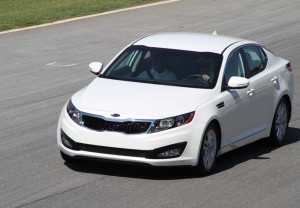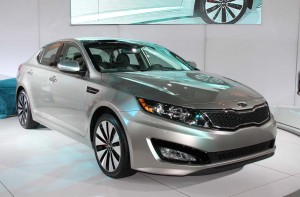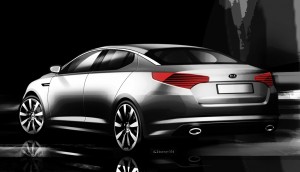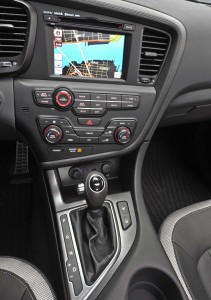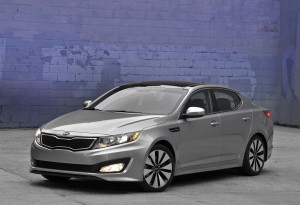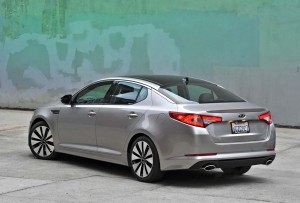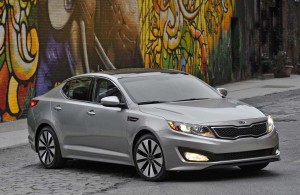
Striking good looks and plenty of features could help the new Optima win a new generation of buyers for Kia.
It’s not often that a single car can redefine a brand. The original BMW 3-Series, for one, the new Hyundai Sonata at the other end of the spectrum. Can Kia pull off the same sort of brand remake when it launches the 2011 Optima, later this year?
The Kia brand has been around for decades, though in its original incarnation its products were used to flesh out the low end of the Ford line-up, cheap-and-cheerful offerings like the Ford Aspire. After it launched its own U.S. dealer network, in 1994, Kia continued to pursue the low end of the spectrum where only three things matter to buyers: price, price and price.
But the automaker’s new crossover, the Kia Sorento, suggests that things just might be in for a big change, and the 2011 Kia Optima, which made its world debut at this year’s New York International Auto Show, is a sign of just how far the Korean carmaker is ready to reach.
Optima is the work of Peter Schreyer, the inordinately talented former Audi chief of design, who joined Kia several years ago with the promise of revamping the maker’s entire line-up. If Sorento and, now, Optima are any indication, Kia could push past its big brother, Hyundai, which took control of the smaller Korean manufacturer in 1997.
The 2011 Kia Optima shares most of its underpinnings with the new and well-regarded Sonata, so when we jumped at the chance for a first drive of Kia’s midsize sedan we had to wonder if it would be little more than a gussied-up clone. To our pleasant surprise, the Optima has not only its own look but a decidedly different feel from Sonata.
To be clear, we only had a relatively brief run behind the wheel in some pre-production prototypes that Kia brought to Road Atlanta, the challenging Georgia track where the automaker’s new race team is headquartered. But that was enough to give us a good sense of what to expect when we clock a bit more time in the 2011 Optima later this month.
Some highly styled automobiles look great on the show stage but lose something when put out on the road. Not the 2011 Kia Optima. It maintains the original appeal that made it a hit at the New York Auto Show.
To understand just how dramatic a change it has undergone consider a chance encounter at the Chop and Lobster Bar, in Atlanta, where we spotted a middle-aged businessman getting the keys to a 2010 Optima from the valet. Seeing us looking at him, he sheepishly announced, “It’s a rental.”
That pretty much defined how most folks used to feel about Kia’s bland and boring designs. The new Optima is the automotive equivalent of a trophy wife. It’s got the long, bold hood, with an equally raked windshield and curvaceous, almost coupe-like roofline of the latest luxury sedans, capped by a sweeping C-pillar and short rear deck. The ’11 Optima will be offered with 16, 17 and 18-wheels, and we expect most buyers will opt up to the two larger alloy offerings, which enhance the car’s subdued muscularity.
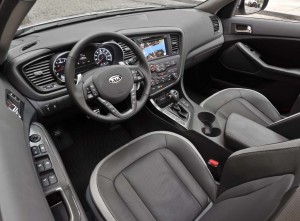
The cabin of the 2011 Kia Optima is well-executed, though a cover over the center console storage bin would've been appreciated.
The 2011 sedan is 190.7 inches long, about 1.7 inches longer than the outgoing Optima. Its wheelbase gains nearly 3 inches, at 110.0 inches. It’s also wider, but an inch lower, which adds to the sporty feel.
The interior moves equally up-market. Kia has adopted a cockpit-like layout, with the center stack angled about 10 degrees towards the drivers. Instruments and controls are elegant and well positioned, the three-gauge instrument cluster looking to be lifted from a mid-range luxury sedan.
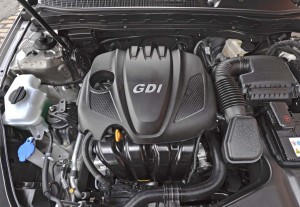
The direct-injection 2.4-liter I4 will eventually be matched by a 2.0-liter turbo and Kia's first hybrid-electric powertrain..
The new Optima’s seats are comfortable, though not overly supportive laterally during hard maneuvers. We were impressed to discover you can opt not just for heated seats up front but for the back, too. And Kia is offering cooled seats, up front, as well.
That underscores the maker’s decision to provide a variety of upscale surprise-and-delight features, such as the optional heated steering wheel and cooled glove box. As we explored the new sedan we kept discovering more examples, such as the tap-to-turn signals, which blink three times with just a touch of the stalk.
Other options include a vast Panoramic sunroof and a 530-watt, 8-speaker Infinity audio system that replaces the standard 6-speaker, AM/FM/CD/Sirius/Aux/iPod package. A nice navigation system is optional, but Bluetooth is standard.
As we earlier noted, the 2011 Kia Optima shares platforms with the Hyundai Sonata. That means it was designed not to use a V6, a risky but ultimately appropriate decision. That engineering move resulted in a lighter, more fuel efficient and nimble package.
The base engine is a respectable 2.4-liter naturally-aspirated inline-four. Its use of direct injection helps the powertrain pump out 200 horsepower and 186 lb-ft of torque, even while delivering 24 mpg City, 35 Highway.
The optional engine, which launches very late in 2010, a bit after the 2.4-liter, is a turbocharged 2.0-liter GDI. The twin-scroll turbo bumps the numbers to 274 hp and 269 lb-ft, while mileage is reduced only slightly, to 22 and 34.
Both engines will be mated to a 6-speed automatic, with paddle shifters, though Kia is also offering a 6-speed manual, an increasingly rare option in the midsize market, these days.
(The automatic gearbox, by the way, will be the transmission of choice when a third engine debuts early in 2011. The first gas-electric hybrid in the Kia line-up, it will mate the 2.4-liter engine with a lithium ion-powered battery drive package. To get a sense of what it’s like, Click Here for our test drive of the 2011 Hyundai Sonata Hybrid.)
The ’11 Optima uses McPherson struts, up front and a multi-link rear suspension. It’s equipped with dual-mode shocks that deliver a reasonably plush ride under normal driving conditions, but which hunker down nicely under more aggressive driving conditions. That’s paired with an electric power-assist steering, or EPAS, system, which helps boost fuel economy by almost 1 mpg.
EPAS technology has improved markedly over the last year or so, and the 2011 Kia Optima is proof positive. There’s as precise an on-center feel as we’ve experienced on all but the most high-line sports cars. Though there’s enough boost to avoid straining in a parking lot, Kia engineers have opted for a very tight and precise, low-boost set-up at highway speeds. That’s notably more performance-oriented than the Sonata. The same is true for the suspension set-up. We could flog the Kia sedan around the undulating Road Atlanta course with only modest and quite predictable body roll. The car only encouraged us to pick up more speed with each lap.
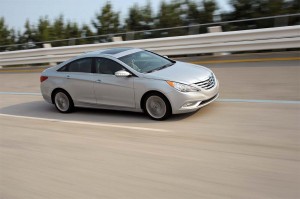
The 2011 Kia Optima shares underpinnings with the new Hyundai Sonata -- and both will get turbo and hybrid powertrains, as well, in the coming months.
We’d like to see even less roll, however, and planning manager Ralph Tjoa suggested that’s something suspension engineers are tinkering with for the turbo model, which will certainly appeal to the sportier of Optima buyers.
To our satisfaction, the 2011 Kia Optima will come with a wealth of safety features, including the usual brake intervention packages, such as ABS and Electronic Stability Control. There’s also Hill Ascent Control, which reduces the likelihood of rolling backwards on a steep hill. No, it’s not the benchmark, but the sedan also boasts 6 airbags, front active headrests and seatbelt pre-tensioners.
In other words, there’s plenty of good things to say about the 2011 Kia Optima. The question is whether people will listen. The brand has been largely invisible to most midsize buyers who aren’t shopping on a limited budget. But the striking looks of the new car are likely to help build awareness. And after checking out the wealth of features and giving the ’11 Optima a test drive, we’re betting many potential buyers will be won over.
We think Kia’s new midsize offering could change the balance of power in the midsize segment.

